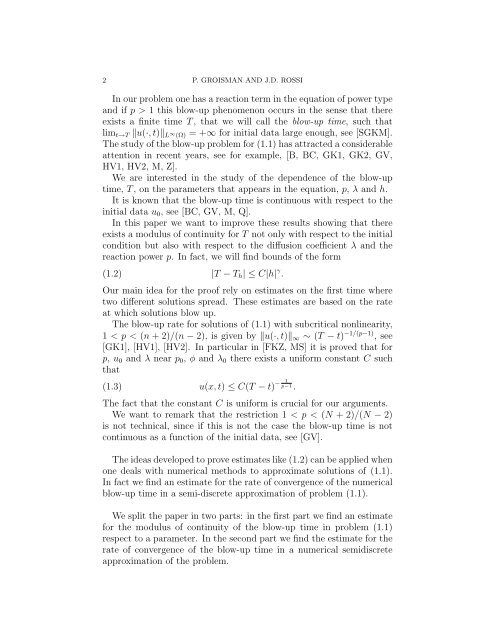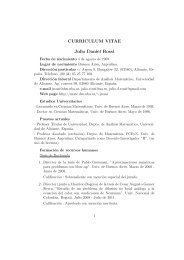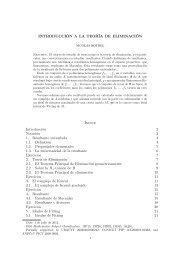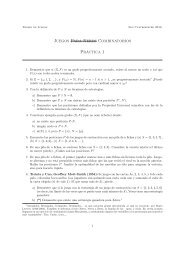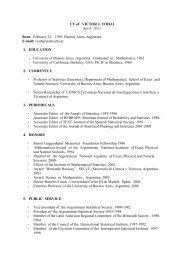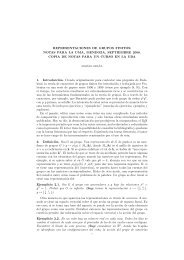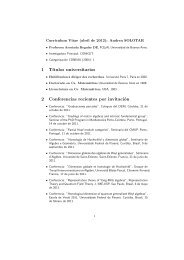Dependence of the blow-up time with respect - Universidad de ...
Dependence of the blow-up time with respect - Universidad de ...
Dependence of the blow-up time with respect - Universidad de ...
Create successful ePaper yourself
Turn your PDF publications into a flip-book with our unique Google optimized e-Paper software.
2 P. GROISMAN AND J.D. ROSSI<br />
In our problem one has a reaction term in <strong>the</strong> equation <strong>of</strong> power type<br />
and if p > 1 this <strong>blow</strong>-<strong>up</strong> phenomenon occurs in <strong>the</strong> sense that <strong>the</strong>re<br />
exists a finite <strong>time</strong> T , that we will call <strong>the</strong> <strong>blow</strong>-<strong>up</strong> <strong>time</strong>, such that<br />
limt→T u(·, t)L ∞ (Ω) = +∞ for initial data large enough, see [SGKM].<br />
The study <strong>of</strong> <strong>the</strong> <strong>blow</strong>-<strong>up</strong> problem for (1.1) has attracted a consi<strong>de</strong>rable<br />
attention in recent years, see for example, [B, BC, GK1, GK2, GV,<br />
HV1, HV2, M, Z].<br />
We are interested in <strong>the</strong> study <strong>of</strong> <strong>the</strong> <strong>de</strong>pen<strong>de</strong>nce <strong>of</strong> <strong>the</strong> <strong>blow</strong>-<strong>up</strong><br />
<strong>time</strong>, T , on <strong>the</strong> parameters that appears in <strong>the</strong> equation, p, λ and h.<br />
It is known that <strong>the</strong> <strong>blow</strong>-<strong>up</strong> <strong>time</strong> is continuous <strong>with</strong> <strong>respect</strong> to <strong>the</strong><br />
initial data u0, see [BC, GV, M, Q].<br />
In this paper we want to improve <strong>the</strong>se results showing that <strong>the</strong>re<br />
exists a modulus <strong>of</strong> continuity for T not only <strong>with</strong> <strong>respect</strong> to <strong>the</strong> initial<br />
condition but also <strong>with</strong> <strong>respect</strong> to <strong>the</strong> diffusion coefficient λ and <strong>the</strong><br />
reaction power p. In fact, we will find bounds <strong>of</strong> <strong>the</strong> form<br />
(1.2) |T − Th| ≤ C|h| γ .<br />
Our main i<strong>de</strong>a for <strong>the</strong> pro<strong>of</strong> rely on estimates on <strong>the</strong> first <strong>time</strong> where<br />
two different solutions spread. These estimates are based on <strong>the</strong> rate<br />
at which solutions <strong>blow</strong> <strong>up</strong>.<br />
The <strong>blow</strong>-<strong>up</strong> rate for solutions <strong>of</strong> (1.1) <strong>with</strong> subcritical nonlinearity,<br />
1 < p < (n + 2)/(n − 2), is given by u(·, t)∞ ∼ (T − t) −1/(p−1) , see<br />
[GK1], [HV1], [HV2]. In particular in [FKZ, MS] it is proved that for<br />
p, u0 and λ near p0, φ and λ0 <strong>the</strong>re exists a uniform constant C such<br />
that<br />
1<br />
−<br />
(1.3) u(x, t) ≤ C(T − t) p−1 .<br />
The fact that <strong>the</strong> constant C is uniform is crucial for our arguments.<br />
We want to remark that <strong>the</strong> restriction 1 < p < (N + 2)/(N − 2)<br />
is not technical, since if this is not <strong>the</strong> case <strong>the</strong> <strong>blow</strong>-<strong>up</strong> <strong>time</strong> is not<br />
continuous as a function <strong>of</strong> <strong>the</strong> initial data, see [GV].<br />
The i<strong>de</strong>as <strong>de</strong>veloped to prove estimates like (1.2) can be applied when<br />
one <strong>de</strong>als <strong>with</strong> numerical methods to approximate solutions <strong>of</strong> (1.1).<br />
In fact we find an estimate for <strong>the</strong> rate <strong>of</strong> convergence <strong>of</strong> <strong>the</strong> numerical<br />
<strong>blow</strong>-<strong>up</strong> <strong>time</strong> in a semi-discrete approximation <strong>of</strong> problem (1.1).<br />
We split <strong>the</strong> paper in two parts: in <strong>the</strong> first part we find an estimate<br />
for <strong>the</strong> modulus <strong>of</strong> continuity <strong>of</strong> <strong>the</strong> <strong>blow</strong>-<strong>up</strong> <strong>time</strong> in problem (1.1)<br />
<strong>respect</strong> to a parameter. In <strong>the</strong> second part we find <strong>the</strong> estimate for <strong>the</strong><br />
rate <strong>of</strong> convergence <strong>of</strong> <strong>the</strong> <strong>blow</strong>-<strong>up</strong> <strong>time</strong> in a numerical semidiscrete<br />
approximation <strong>of</strong> <strong>the</strong> problem.


